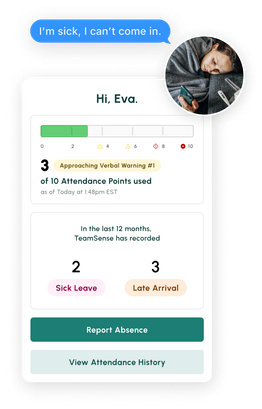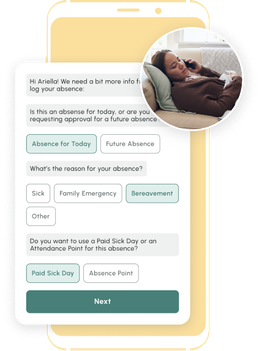Fix the root cause of No-Call No-Show with help from TeamSense
Table of Contents
- What is Employee Absenteeism?
- Absenteeism in the Workplace Statistics: General Statistics
- 1. The yearly cost of employee absenteeism is 225.8 billion dollars.
- 2. In 2024, the absence rate was at 3.2%.
- 3. Almost 50% of overtime is used to cover employee absences.
- 4. The estimated loss of productivity due to unplanned absence reaches almost 40%.
- 5. Employers notice an increase in absences on Mondays and Fridays and before public holidays and sporting and national events.
- 6. More than half of large employers (1,000+ employees) reported using a manual or no systematic process to manage absenteeism.
- 7. HR managers are handling more requests for leave than ever before.
- 8. Both small and large companies are planning to digitize their HR efforts.
- 9. Companies using attendance tracking software have seen almost a 20% reduction in absence rates.
- Absenteeism in the Workplace Statistics: Reasons for Employee Absences
- Absenteeism in the Workplace Statistics: Absenteeism by Industry
- In the manufacturing industry, injury and illness are the leading causes of absences.
- Healthcare support occupations have the highest absence rate in the U.S. at 4.3%.
- While professional and technical services occupations have the lowest absence rate at 2.4%.
- A third-party logistics company was able to reduce their absenteeism by 39% using TeamSense.
- More About Employee Absenteeism
- Reduce Employee Absenteeism with TeamSense
If you're an HR professional or manage a large number of hourly employees, then the topic of absenteeism is no doubt always top of mind. But, how much of what you're dealing with is normal, and how much is not?
Absenteeism in the workplace has increased in the past five years—and one in 10 employees are absent on days they’re scheduled to come to work. While planned PTO is standard, when employees don’t show up, supervisors have to scramble to fill shifts, coworkers have to cover their team members, and productivity can tank.
To get to the bottom of it, we've put together some of the most impactful statistics about absenteeism in the workplace. We hope that they provide clarity on the costs of absenteeism, why employees miss work, and what industries are impacted the most. Let’s dive in!
What is Employee Absenteeism?
Employee absenteeism is a habitual pattern of being absent from work that goes against the accepted employee attendance policy. This isn’t when employees are using their PTO. Rather, they call in last minute or are even "no-call, no-shows."
There are several reasons why an employee may miss work, from being sick or having to take care of a loved one. However, excessive absenteeism can be a significant problem for businesses when it leads to decreased productivity, poor morale among other staff, and increased costs due to the need for temporary replacement staff or overtime payments.
Absenteeism in the Workplace Statistics: General Statistics
These statistics on absenteeism in the workplace cover absenteeism rates, the cost of absenteeism, common days employees are absent, and much more. If you're looking for some interesting trends in Absenteeism, be sure to check out this article.
1. The yearly cost of employee absenteeism is 225.8 billion dollars.
There’s no doubt about it: $225.8 billion is a lot of money…that comes out to $1,685 per employee, per year. Why is absenteeism so costly? Absenteeism not only reduces productivity, but can also lead to increased spending on hiring and onboarding new employees, paying overtime for employees covering open shifts, and unplanned downtime.

Is your call-in process terrible? Text reduces no-shows and absenteeism by up to 40%.
Don't believe us? Check out this case study to see how this 3PL benefited.
2. In 2024, the absence rate was at 3.2%.
The Bureau of Labor Statistics reported the national absence rate to be 3.2 percent in 2024, up .1% from 2023's absence rate of 3.1 percent, with the leading causes being injury and illness. Workers may also start missing work if they're unhappy with their job, are struggling with mental health issues, are experiencing harassment in the workplace, or are suffering from burnout.
Concerned about your absence rates? Make an employee attendance improvement plan with this guide.
3. Almost 50% of overtime is used to cover employee absences.
Just because an employee can’t make it to work doesn’t mean the work stops. So it’s no surprise that 47% of overtime is used to cover shifts when team members are out.
While it’s important to take time off, when it’s unplanned–and even when it’s planned–employee absences require managers to rearrange work schedules and may mean that coworkers have to manage larger workloads that could take longer than an average work day to complete.
Excessive absenteeism could cause these coworkers to feel overworked, experience job dissatisfaction, and in worst cases, lead to a hostile work environment.
4. The estimated loss of productivity due to unplanned absence reaches almost 40%.
Productivity loss varies by the type of employee absence, with the average productivity loss associated with an unplanned absence being the highest at 36.6% while the average productivity loss related to a planned absence comes in at 22.6%
5. Employers notice an increase in absences on Mondays and Fridays and before public holidays and sporting and national events.
Almost three-quarters of employers saw more employee absences on Mondays and Fridays, before sporting events and national events, and before public holidays. In 2025, roughly one in five surveyed Americans said that they planned to take off work the Monday after the Super Bowl. Tracking and finding patterns in employee absences can help employers better prepare for shifts in employee absences.
6. More than half of large employers (1,000+ employees) reported using a manual or no systematic process to manage absenteeism.
According to a study done by ADP, large employers are still relying on manual methods to track workplace attendance. These employers find that they have a harder time enforcing their attendance policies and see repeated unplanned absences.
7. HR managers are handling more requests for leave than ever before.
Employees are asking more frequently for leave and accommodations, with 62% of managers seeing an increase in leave requests and 72% seeing more requests for accommodations. The top reason employees requested time off was to manage mental-health related issues (55%).
8. Both small and large companies are planning to digitize their HR efforts.
In a 2023 Paychex survey, 81% of HR leaders said they planned to use technology to digitize HR functions, including tracking time and attendance, or were already doing so. Nine in 10 large businesses were committed to digitizing their HR programs, while 80% of smaller businesses said the same. Opinions were more split around the use of AI technology: 49% of large businesses were likely to use AI technology, while just 25% of smaller businesses were.
9. Companies using attendance tracking software have seen almost a 20% reduction in absence rates.
There’s hope in the world of employee absenteeism. Compared to the first half of 2022 to the first half of 2023, manufacturing organizations using our absence tracking software TeamSense saw a 17% drop in absence rates. Why does our software work so well to reduce absences?
TeamSense’s text-based platform makes it easier than ever to call in or request time off from work. Using text messages to call off means your employees can use a technology they’re familiar with—no apps to download, no company login information to remember, and no manual paperwork.
All employees have to do is text a keyword to their company’s number and fill out the short survey they receive back. Managers and supervisors are immediately alerted so they can fill shifts faster and keep the line running.
Absenteeism in the Workplace Statistics: Reasons for Employee Absences
Now that we’ve covered some general employee absenteeism statistics, let’s take a look at some of the reasons employees call out.
1. In January 2024, nearly 3% of full-time workers were absent from work due to health-related issues.
Illness-related absences from work have been relatively low during the 2024-2025 flu season. In other years, we’ve seen spikes in absenteeism due to illness: January 2022 saw a steep increase in absences at a rate of 5.4%.
2. Workplace absentee rates vary greatly by state.
Certain strains of flu and other illnesses hit harder in some regions than others. This year, Ohio had the highest workplace absentee rate, with 5.66% of workers calling out in Feb 2025. Georgia’s absentee rate was the lowest, with just 1.57% of workers absent.
3. More than 44,000 workers call off each month due to childcare shortages.
According to BLS data, failure to find childcare while working resulted in more than half a million absences each year in 2024. While that’s lower than the peak in 2020 (792,000 absences), it’s still higher than pre-pandemic levels (396,000 absences in 2019).
4. Over 304,000 workers are absent each month due to personal reasons.
In 2024, more than 3.6 million workplace absences occurred due to “other family or personal obligations,” not including childcare. This may include situations such as elder care, supporting another sick family member, or transportation issues.
While you can’t control what happens in your employees’ personal lives, you can create strategies to support them so they can better manage any personal issues they’re experiencing. Offering flexible office hours, hosting regular check-ins and open forums, and providing Employee Assistance Programs (EAPs) or counseling services can all help prevent absences in the future.
Read more here on how to reduce employee absenteeism.
5. Missed work due to mental health issues is estimated to cost the U.S. economy $47.6 billion annually in lost productivity.
In addition to physical illness, employees’ mental health can also have a huge impact on their attendance rates. Approximately 25% of US employees consider their mental health fair or poor.
This group of employees is reported to have almost four times more unplanned absences within a year with nearly 12 unplanned leaves, while employees reporting good to excellent mental health only take about 2.5 unplanned leaves.
6. Women who work full-time have higher health-related absence rates than men.
Women have to call off work more frequently than men due to health or injury. In 2024, the average absentee rate for women was 4%, compared to 2.6% for men.
7. Stress can cause up to a million employees to miss work every day–costing US businesses up to $300 billion a year.
Stress causes almost a million workers to miss work every day. This stress may come from external factors or from within the workplace itself, with 83% of US workers suffering from work-related stress.
Job-related stressors including complex job demands, little control over one's work, long work hours, and a lack of friends at work can all contribute to depression.
8. In addition to stress, depression can also have a huge impact on absenteeism in the workplace.
One in five adults will have a clinically significant case of depression at some point in their life. For businesses, depression in their employees can cost as much as $187.8 billion, due to the combination of health care costs, productivity impacts, and absenteeism.
9. Poor sleep results in $44.6 billion in lost productivity each year.
An estimated 7% of workers aren’t getting enough high-quality sleep—and as a result, their absentee rates are double that of those with good sleep schedules. They miss an average of 2.29 days of work each month, equating to $44.6 billion in lost productivity for U.S.-based businesses.
10. Inconsistency in scheduling leads to higher absenteeism and tardiness in shift-based workers.
A study analyzing more than 28 million time cards for retail shift-based workers found that inconsistency in shift scheduling had a strong correlation to both tardiness and absences. In 37% of shifts, the shifts were either scheduled on a day of the week the employee didn’t work previously, or the start time differed by more than an hour. In these cases, 16% of workers were late or absent.

Absenteeism in the Workplace Statistics: Absenteeism by Industry
This next round of stats demonstrates how absenteeism can look different for every industry and occupation.
In the manufacturing industry, injury and illness are the leading causes of absences.
According to the Bureau of Labor Statistics, full-time workers in the manufacturing industry are more likely to miss work due to an injury or illness (2%). Overall, the manufacturing sector has a 2.8% absenteeism rate.
Healthcare support occupations have the highest absence rate in the U.S. at 4.3%.
Healthcare support occupations such as nursing assistants, homecare aides, and physical therapists saw the highest absence rate last year, followed by community and social service occupations (4.2%), and buildings and grounds cleaning and maintenance occupations (4%).
While professional and technical services occupations have the lowest absence rate at 2.4%.
Out of all the industries listed in a report from the Bureau of Labor Statistics, professional and technical services workers had the lowest absence rate.
A third-party logistics company was able to reduce their absenteeism by 39% using TeamSense.
A third-party logistics company slashed its absenteeism rates by 39% thanks to TeamSense’s text-based attendance management system. Our platform replaced their manual absence management process in less than 24 hours to help them reduce absenteeism and their overstaffing spend.
The company was successful in both of those goals and was also able to keep employees accountable for their attendance, track and monitor absences, save thousands in shift payout each month, and see a decline in employee terminations due to excessive absences.
More About Employee Absenteeism
Now that we’ve covered some interesting statistics on employee absenteeism, here is some more helpful information on how to crack the code on absenteeism in your workplace.
How Do You Track Employee Absenteeism?
Tracking employee absences is easier said than done, especially if you oversee many employees. However, a sure way to monitor employee attendance can help prevent absenteeism.
There are plenty of ways to manage and track attendance, like using a hotline or centralized telephone or a group text or messaging apps like GroupMe or WhatsApp.
Or, you can use a text-based attendance solution like TeamSense! Our simplified attendance system gives employees a simplified way to report when absent from work. No need to download any apps or create logins–all your employees have to do is send a text and fill out a quick survey. You get notified the moment an employee sends in their absence, making it easier for you to make any adjustments or assign shifts to cover the absence.
Effortless attendance tracking is just a text away.
Absenteeism Rate Formula
The formula for calculating the absenteeism rate determines the proportion of time an employee has been absent from work over a certain timeframe.
To find the number of absences during a certain period, divide the total number by the overall number of workdays, not including weekends or holidays, then multiply the result by 100.
What is an Acceptable Absenteeism Rate?
Your absenteeism rate is never going to be zero. Having a team that never misses work is unrealistic. As a manager, you should be promoting a work-life balance and encouraging your employees to take time off.
That being said, organizations try to shoot for absenteeism rates of around 1.5%. Still, it’s normal for rates to get a little higher, such as during a flu or COVID season.
Presenteeism vs Absenteeism
We have an idea of what you may be thinking: Isn’t presenteeism the opposite of absenteeism? Doesn’t that make it a good thing? No, not always.
Presenteeism at work is when an employee shows up to work no matter the circumstances. The employee could be injured, sick, exhausted, or suffering from burnout. While it might feel great in the moment to have dedicated employees, it also puts you and your department at risk for more absences.
For example, if an employee shows up to work sick, they can potentially spread their illness to everyone in the workplace. So, instead of one absent employee, you’ve got multiple. This severely impacts your workflow, productivity rate, sales, and more. Other departments may have to lend you their employees, which puts a strain on their workflow too.
Presenteeism can cause a domino effect that can take a while to recover from. So instead of unwavering attendance, encourage your employees to use their planned PTO and avoid losing more employees to illness, injury, and burnout.
How Do You Reduce Employee Absenteeism?
Unchecked absenteeism can lead to lost work days, missed deadlines, and decreased morale in the workplace. To help prevent or reduce absenteeism, here are a few simple but effective steps you can take.
Use an absence tracking system: Absence tracking software simplifies employee time tracking, shift scheduling, labor law compliance, and much more.
Encourage employees to use their vacation or PTO days: Instead of not showing up to work, have them take advantage of their PTO time. They can use their vacation time to relax and return with a better mindset. Plus, planning is your HR team’s best friend.
Offer a flexible work environment: As the saying goes, life comes at you fast. Employees who lead busy personal lives might respond better to more flexible work arrangements such as working remotely or alternative shifts.
Provide mental health resources to your employees: These employee absenteeism statistics demonstrate how poor mental health, stress, and depression can lead to higher absence rates. Offering mental health resources and creating a space where employees can openly discuss their concerns, receive counseling, and support communities, can help lower absences and build employee trust.
Have regular check-ins with employees: Regular check-ins with your employees can help improve communication and connect with your team on a more personal level. You can use this time to create personal relationships with your employees, offer advice, and help them succeed in the workplace.
Enforce the attendance policy fairly: Enforcing and upholding your attendance policy is one of the best ways to stop absenteeism. Be clear and straightforward about expectations and then enforce them fairly across every employee and team. If you have to listen to your employees' concerns and revise or re-write your attendance policy.

No one wants to talk to their boss or a 1-800 stranger to call off. Text changes everything - Reducing No Call No Shows.
Reduce Employee Absenteeism with TeamSense
Hopefully, some of these absenteeism statistics inspired you to start talking to your employees about absenteeism. We know preventing absenteeism in the workplace is an ongoing battle, so we’re here to help.
TeamSense offers HR teams and managers like you more room to breathe with our unique, text-based attendance tracking system. Say goodbye to chaotic call-offs and take control of absenteeism with accurate, data-driven solutions.
Frequently Asked Questions
-
Absenteeism rates can significantly vary across different industries due to the nature of the work, stress levels, physical demands, and the work environment. For example, industries with high physical demands or stressful work environments may experience higher absenteeism rates. Understanding these variances can help tailor specific strategies to address absenteeism in each sector.
-
Yes, a positive workplace culture that promotes employee well-being, recognition, and work-life balance can significantly reduce absenteeism. Employees are more likely to be engaged and committed to their work when they feel valued and supported by their employer.
-
High levels of employee engagement are often associated with lower absenteeism rates. Engaged employees are more motivated, have a stronger connection to their work and company, and are less likely to take unnecessary time off.
-
Data analytics can provide insights into absenteeism patterns, helping organizations identify underlying causes and trends. This information can be used to develop targeted interventions and measure the effectiveness of absenteeism reduction strategies over time.
-
Yes, employers must navigate absenteeism with an awareness of legal frameworks such as the Americans with Disabilities Act (ADA) and the Family and Medical Leave Act (FMLA). It's crucial to ensure that efforts to reduce absenteeism do not discriminate against employees with legitimate reasons for their absences.
About the Author

Sheila Stafford, CEO of TeamSense & AI in HR Innovator
As CEO of TeamSense, Sheila Stafford is at the forefront of transforming HR for frontline teams through AI-driven solutions. With a commitment to enhancing employee relations and simplifying workforce management, Sheila leads TeamSense in pioneering advancements that empower both frontline employees and HR teams. Her visionary approach combines cutting-edge technology with a thoughtful focus on enhancing human connection; Sheila strategically implements AI where it adds the most value while recognizing the critical role of personal interaction and ensuring that human engagement remains central when it matters most. Under her leadership, TeamSense is redefining how companies support and engage their frontline teams for a more connected, efficient workplace.


